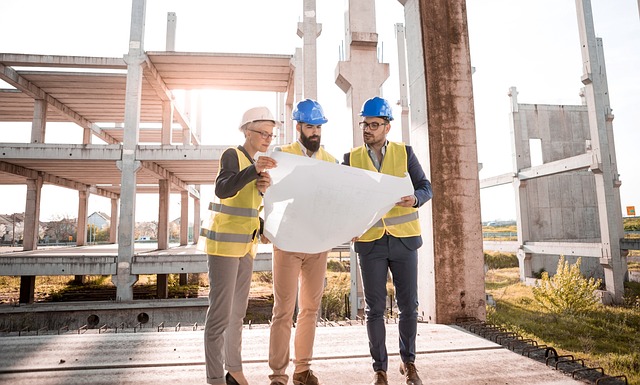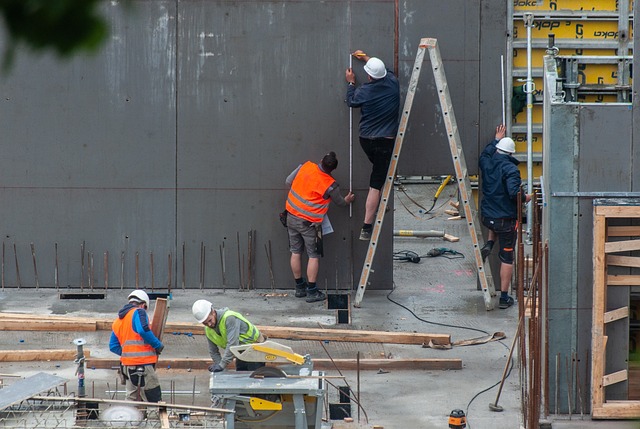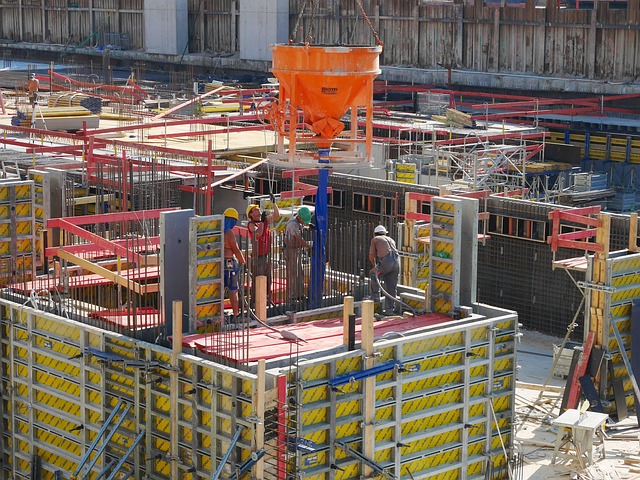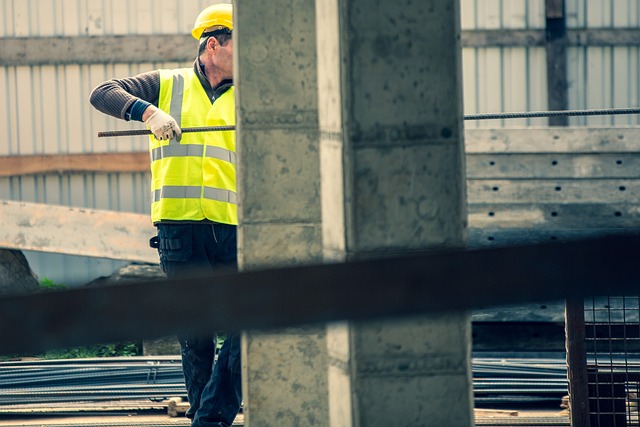The introduction of advanced hands-free flashlight systems for construction workers has revolutionized the industry by enhancing safety, productivity, and workmanship. These devices, such as headlamps and clip-on lights with LED technology, offer a range of benefits including durability, adjustable brightness settings, and versatile positioning to suit various tasks and environments. They provide unobstructed hands-free illumination, essential for precise operations like welding and operating heavy machinery, and have significantly reduced the risk of accidents by eliminating the need to hold a flashlight while working. The ergonomic design of these systems minimizes strain and fatigue, supporting natural head and eye positions, and incorporates daylight simulation to alleviate eye strain in different lighting conditions. Their adoption has led to a notable increase in efficiency and a decrease in incidents on construction sites, making flashlights for construction workers an indispensable component of modern construction workflows. Case studies from diverse projects underscore their practical benefits in terms of safety, efficiency, and the preservation of architectural integrity.
Constructing a brighter, safer work environment is paramount in the field of construction. The integration of hands-free lighting solutions has revolutionized precision tasks, offering unparalleled freedom and illumination where traditional flashlights fall short. This article delves into the transformative role of hands-free lighting systems, tracing their evolution from rudimentary flashlights for construction workers to sophisticated devices designed with ergonomics in mind. We will explore key features that distinguish high-quality hands-free lighting solutions and discuss how these innovations enhance safety on bustling construction sites. Additionally, we’ll examine the latest advancements in LED technology, battery longevity, and durability that have set new standards for flashlights used by construction workers. Through case studies showcasing real-world applications, this article will shed light on the tangible benefits of hands-free lighting, making it an indispensable tool for the modern construction professional.
- Understanding the Role of Hands-Free Lighting in Construction
- The Evolution of Flashlights for Construction Workers
- Key Features to Look for in Hands-Free Lighting Solutions
- How Hands-Free Lighting Enhances Safety on Construction Sites
- The Impact of Ergonomic Design and Wearable Lighting Devices
- Advanced Technologies in Hands-Free Flashlights: LEDs, Battery Life, and Durability
- Case Studies: Real-World Applications of Hands-Free Lighting in Construction Projects
Understanding the Role of Hands-Free Lighting in Construction

Construction sites are complex environments where precision and safety are paramount. Traditional handheld flashlights have long been a staple for construction workers, providing illumination in areas that lack sufficient lighting. However, these methods can be less than ideal, as they require manual operation which can be inconvenient or even hazardous when both hands are needed for tasks such as welding, cutting, or operating machinery. Hands-free lighting solutions have emerged to address these challenges, offering construction workers the ability to keep their hands free and their work areas well-lit simultaneously. These solutions range from headlamps to wearable lights attached to hard hats or clothing, ensuring that light is directed exactly where it’s needed most. This not only enhances visibility for tasks requiring meticulous attention but also significantly improves safety on site by allowing workers to maintain a clear and safe workspace. Flashlights for construction workers, when hands-free, are particularly beneficial as they eliminate the risk of dropping a light or accidentally turning it off mid-task. The integration of these lighting systems into the daily operations of construction sites has led to increased productivity and a reduction in accidents caused by insufficient visibility. As such, the adoption of hands-free lighting is becoming an integral component in the modern construction worker’s toolkit, facilitating both efficiency and safety in the demanding conditions of the job.
The Evolution of Flashlights for Construction Workers

The role of flashlights in construction has undergone significant transformation over the years, reflecting broader technological advancements and shifts in industry practices. Early on, construction workers relied on traditional flashlights, which were bulky, not very durable, and had limited battery life. These early tools often hindered rather than aided work, as their design necessitated frequent handling, interrupting the workflow and posing a potential risk of dropping them onto sensitive equipment or into hazardous areas.
As technology progressed, flashlights for construction workers evolved to become more efficient, reliable, and versatile. The introduction of LED technology marked a pivotal point, as it offered brighter, longer-lasting light with better energy efficiency. This innovation led to the development of hands-free lighting solutions, such as headlamps and clamp lights, which allowed workers’ hands to remain free for tasks that required precision, whether they were working on electrical systems, masonry work, or intricate carpentry. The evolution of flashlights in the construction sector has not only enhanced worker safety by reducing the risk of accidents but also significantly increased productivity and the quality of workmanship through the hands-free functionality that these modern lighting solutions provide.
Key Features to Look for in Hands-Free Lighting Solutions

When selecting hands-free lighting solutions, particularly for precision tasks in construction environments, it’s crucial to consider several key features that can enhance worker safety and task efficiency. Firstly, durability is paramount; construction sites are not kind to equipment. Lighting devices should be built to withstand drops, exposure to elements, and the rough handling they may encounter daily. Secondly, adjustable lighting options allow workers to tailor brightness levels to their immediate surroundings, which is essential for tasks that require fine detail visibility without causing strain or glare on digital screens or materials. For construction workers who often operate in tight spaces or under hoods, a light’s versatility in positioning cannot be overstated. Clip-on lights with goosenecks offer flexibility in directing light precisely where it’s needed. Additionally, LED technology is preferred for its energy efficiency and longevity, reducing the need for frequent battery changes or recharging. Features such as a focused beam and hands-free operation free workers from holding bulky flashlights, allowing them to use their hands for their intended task without compromising on lighting quality. Incorporating a headlamp or a wearable light with an adjustable headband can be particularly beneficial for tasks that require both hands. When investing in flashlights for construction workers, prioritize models with user-friendly interfaces and reliable battery indicators to ensure continuous operation when it’s most needed. With these features in mind, construction workers can maintain optimal visibility and performance, leading to safer and more efficient job sites.
How Hands-Free Lighting Enhances Safety on Construction Sites

The integration of hands-free lighting into construction sites through flashlights for construction workers has significantly enhanced safety and efficiency. These devices, often in the form of headlamps or smart glasses, allow workers to keep their hands free for tasks that require dexterity and precision, such as wiring, masonry, or carpentry. The absence of free hands not only streamlines the workflow but also reduces the risk of accidents caused by fumbling for a traditional flashlight while working at heights or in tight spaces. Additionally, these hands-free lighting solutions offer superior lighting control, enabling workers to direct light exactly where it’s needed, which is crucial when performing intricate tasks. The adjustable brightness settings cater to various conditions, from dimly lit interiors to outdoor environments hit by changing weather patterns. By ensuring that construction workers’ hands remain unobstructed, hands-free lighting contributes to a safer work environment, one where the focus can be on the task at hand without the distraction or danger of holding a light source. This not only accelerates project timelines but also helps in minimizing workplace injuries and enhancing overall safety on construction sites. Flashlights specifically designed for construction workers are an investment in their well-being and the quality of work performed.
The Impact of Ergonomic Design and Wearable Lighting Devices

The integration of ergonomic design in hands-free lighting solutions, particularly flashlights for construction workers, has significantly enhanced the efficiency and safety of precision tasks in the field. These devices are crafted with a deep understanding of human anatomy and the typical environments in which construction workers operate. The result is lighting that not only illuminates the area but also contours to the natural position of the head and eyes, reducing strain and fatigue. This ergonomic consideration ensures that the light is directed exactly where it’s needed most, allowing for unimpeded work without the need to hold a flashlight or adjust its position constantly. The benefits extend beyond comfort; they directly impact productivity as well. By freeing up the hands, workers can manipulate tools and materials with greater dexterity, leading to higher quality work and faster completion times.
Wearable lighting devices have evolved into sophisticated tools that go beyond mere illumination. Modern flashlights for construction workers are equipped with advanced technologies such as adjustable brightness settings, which simulate daylight conditions to mimic natural light, thus reducing eye strain and improving visibility in varied conditions. These devices often come with headbands or helmets with built-in lighting, ensuring that both hands remain free for the task at hand. The heads of these lights can be tilted or swiveled to cast light exactly where it’s needed, a feature that is particularly beneficial in confined spaces or when working at heights. The combination of ergonomic design and wearable technology not only enhances safety and efficiency but also adapts to the dynamic needs of construction workers, making these lighting solutions indispensable on modern construction sites.
Advanced Technologies in Hands-Free Flashlights: LEDs, Battery Life, and Durability

Case Studies: Real-World Applications of Hands-Free Lighting in Construction Projects

In the realm of construction, where precision and safety are paramount, hands-free lighting solutions have proven to be invaluable tools for workers. Flashlights designed specifically for construction workers are now equipped with hands-free functionality, allowing professionals to maintain optimal visibility without sacrificing their manual tasks. A case study from a major infrastructure project illustrates this point clearly. Workers on site utilized headlamps and clip-on lights that were attached to hard hats, which significantly improved their ability to navigate complex tasks in low-light conditions. The hands-free feature enabled electricians to work with wiring in confined spaces more safely and effectively, while masons and carpenters found their hands unobstructed for precise work like laying tile or installing trim. This adaptability of hands-free flashlights has led to increased productivity and a reduction in accidents caused by traditional handheld torch usage.
Another case study comes from the renovation of a historic building, where the preservation of architectural integrity was critical. The construction crew employed hands-free lighting systems that emitted minimal heat and had adjustable brightness levels. This allowed for delicate restoration work to be performed under optimal conditions, with workers’ hands free to handle fragile materials without the risk of fire or damage from a traditional flashlight or lamp. The project’s success in preserving the building’s original features while adhering to modern safety standards was partly attributed to the thoughtful integration of such advanced lighting solutions. These examples underscore the practical benefits and real-world applications of hands-free lighting systems for construction workers, highlighting their role in enhancing both safety and efficiency on job sites.
In conclusion, the integration of hands-free lighting solutions, such as flashlights for construction workers, has revolutionized the precision and safety of tasks within the industry. The evolution from traditional flashlights to advanced, wearable lighting devices with ergonomic design has not only improved the working conditions but also increased efficiency and productivity on construction sites. With key features like long-lasting LED illumination, superior battery life, and robust durability, these tools have become indispensable for construction workers who require both hands to be free for their tasks. The case studies presented underscore the tangible benefits of such lighting systems in real-world settings, proving their value beyond mere convenience. As the technology continues to advance, it is clear that flashlights for construction workers will only become more integral to the safety and success of the industry.
